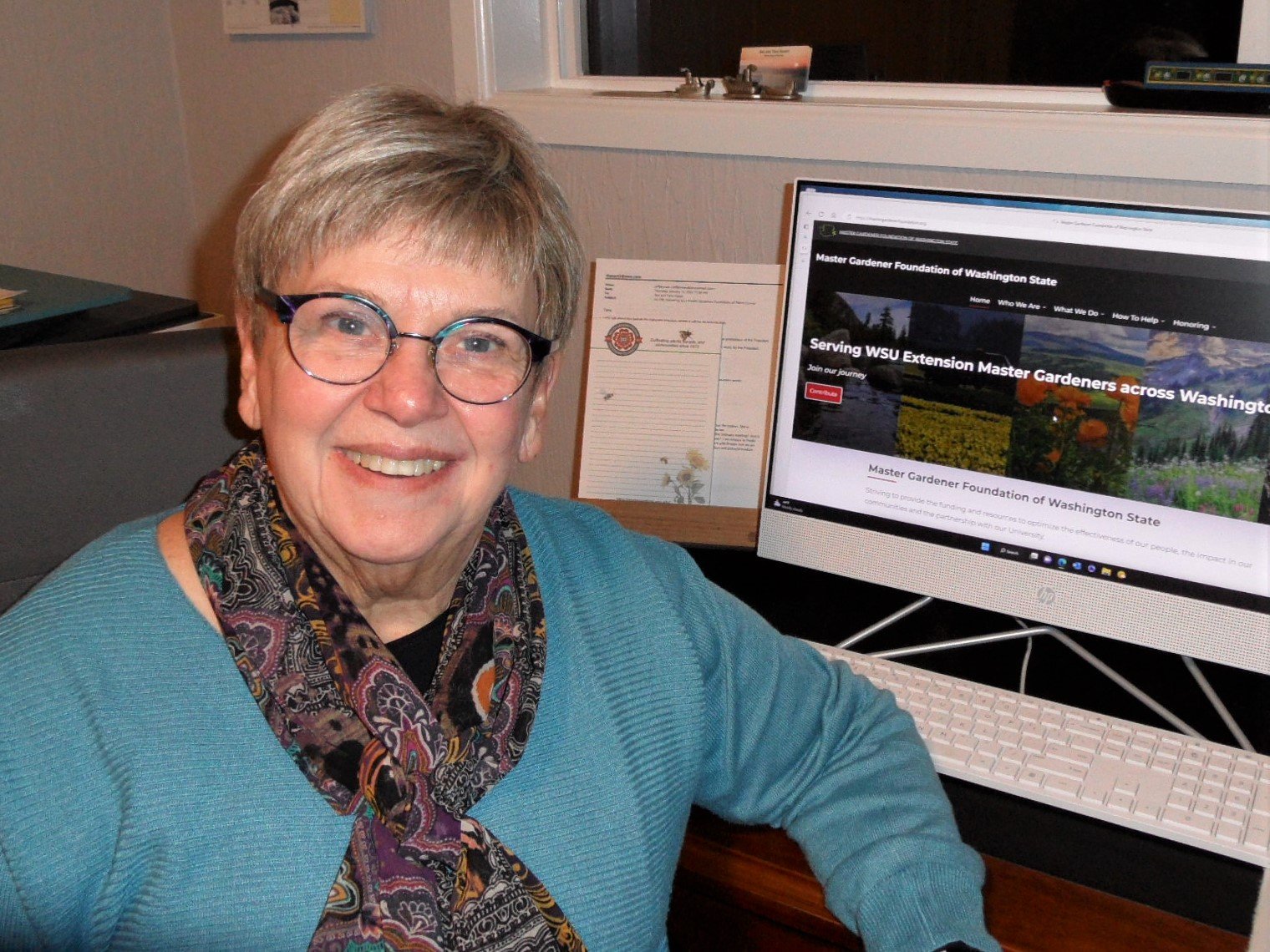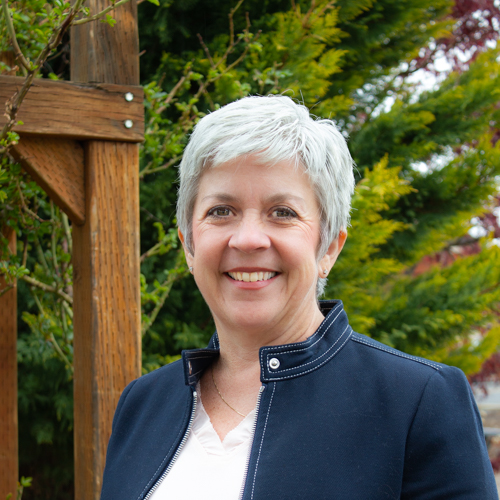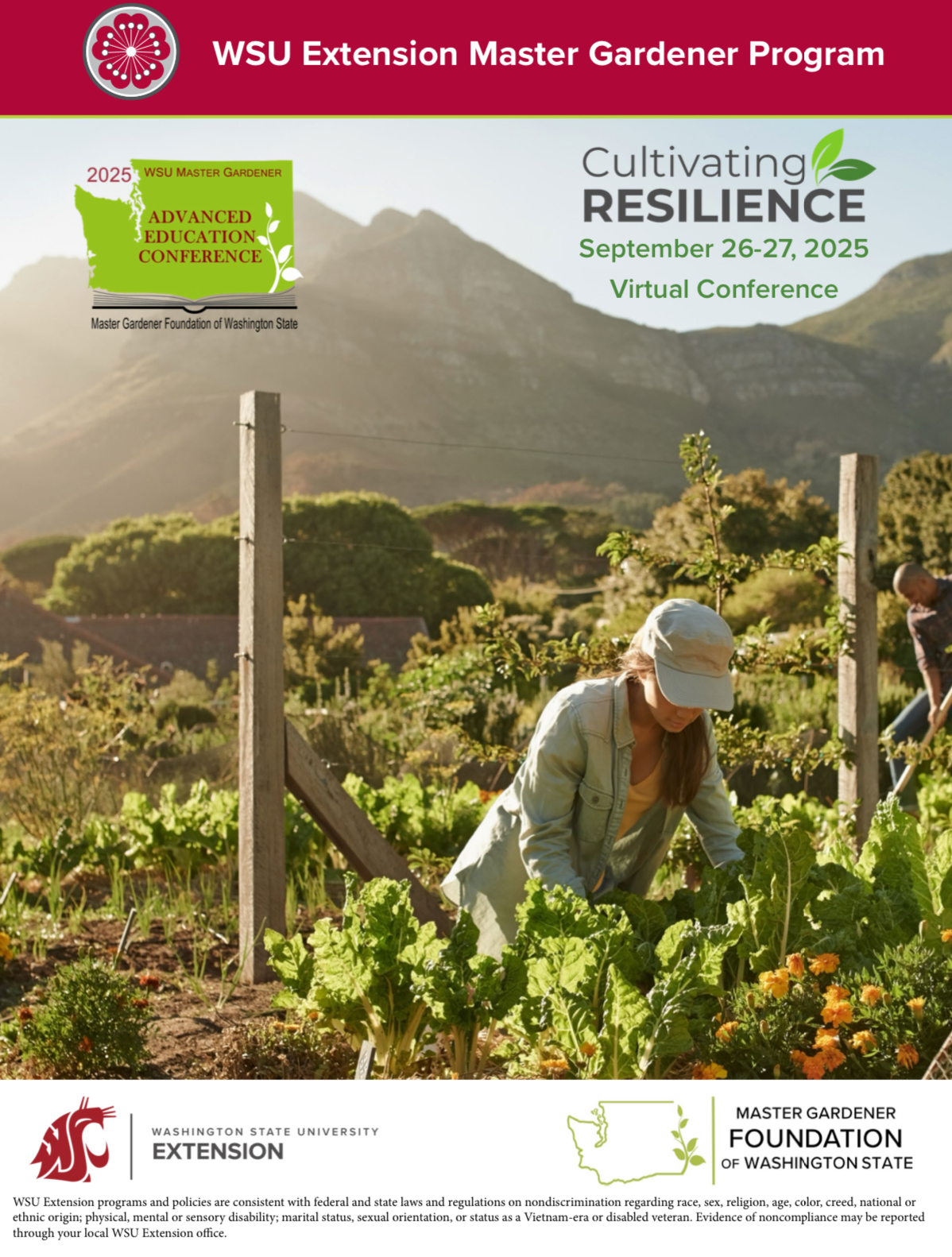Sharing Success and Educating Each Other
Seeds for Thought is the quarterly newsletter of the Master Gardener Foundation of Washington State.
Issues are published on February 1, May 1, August 1, and November 1. All content is submitted by WSU Extension Master Gardeners.
Submission Guidelines
Articles should be in a Word or Google document with JPG photos attached separately. Photo credits must be provided and the identity of MGs in the photos is appreciated. Fliers or announcements of upcoming events are also welcome in JPG format. Please email submissions to newsletter@mastergardenerfoundation.org
| Publication Date | Submissions Due |
| February 1 | January 1 |
| May 1 | April 1 |
| August 1 | July 1 |
| November 1 | October 1 |
-

Seeds For Thought
A newsletter of the Master Gardener Foundation of Washington State
May 2025 – Volume 25, Issue 2
From the President
~~ Tana Hasart, MGFWS President

Showing up and Being There is the Key
On a recent trip to England, I marveled at the country similarities that can be found at this time of year. Nurseries were bursting with plants, many of which come to the UK from Spain and the Netherlands, interestingly enough. Let’s just say that our son’s yard looks somewhat different than before our visit! Villages and towns actively engage in planting wonderful displays in the centers of their locations, competing in a country-wide contest that rewards good work and encourages beautification. And the widespread dedication to “No Mow May” encourages dandelions and other lawn residents to be ready for the pollinators who count on them for food.
Just as is the case overseas, this time of year is incredibly busy, with many Programs and Foundations getting ready for plant sales, intern graduations, budget planning, and engagement with the community during our prime growing season. I am grateful for the many opportunities to lend support to the WSU Extension Master Gardener Program’s advancement of important goals.
The 2025 NW Flower and Garden Festival was a success thanks to talented volunteers, a dedicated planning team, and our adoring public. This event presents our statewide program in ways that inform and engage gardeners while also attracting individuals to join our ranks. When asked about their experience, volunteer MGs offered the following:
From a first-time NWFGF volunteer: Great chance to network with other counties, MGs that visit the booth, and visitors from WSU. These relationships will go a long way in strengthening my county’s program by having additional insight and knowledge of how “others are doing it.”
And from a seasoned volunteer: Even though our county is in Eastern Washington, this is an opportunity to attract new people to the program. If they live in Western Washington, they may help spread the word to those they know from other locations, so I see the outreach impact as being positive for everyone.
The MGFWS voted unanimously to sponsor the NWFGF for 2026, so put a reminder on your calendar to sign up for a wonderful volunteer experience.
On a more recent note, work to update the WSU, state, and county foundation Memorandum of Agreement template is nearing completion. Coordinator and foundation president teams from Clark, Pierce, and Whatcom counties joined Jennifer Marquis, Cathi Lamoreux, and me in reviewing and recommending revisions to this important document. Our conversations were honest, transparent, and informative. The process demonstrated that, while there are many different ways to conduct business, our abiding partnership remains strong and resilient. The next steps in this process are a review by the WSU contract and legal entities, followed by an assessment by an attorney representing the Master Gardener Foundation of Washington. Our goal is to have the resulting template ready for use by early summer, accompanied by an explainer document. The Program and MGFWS will be reviewing the local county charter and charter renewal process to ensure alignment with the content of the template.
Whether reflected in far-reaching efforts that support good horticultural practices or engagement in work that supports statewide advancement, nothing is accomplished without the engagement of dedicated people. Thank you for showing up in so many ways and for being there to lend support and insight.
– Tana
From the Statewide Program Leader
~~ Jennifer Marquis, WSU Extension Master Gardener Program Statewide Leader

Green School: Cultivating Sustainable Gardening Practices
Green School, offered by Washington State University Extension, is a comprehensive educational program designed to empower gardeners with research-based horticultural and environmental stewardship practices. This curriculum is tailored to address the unique challenges of gardening in Washington’s diverse climates, promoting sustainable and environmentally responsible gardening techniques to improve the experience of gardening and to protect our natural resources.
Program Overview: Green School provides two distinct tracks to cater to different levels of gardening interest and commitment. The Washington Gardener Certificate Track is ideal for individuals looking to enhance their gardening skills through online courses that cover a wide range of topics, including soil health, water conservation, pest management, and plant propagation. Upon successful completion, participants earn a Washington Gardener Certificate, which can be used to supplement resumes, promote businesses, or simply grow gardening knowledge.
For those who wish to take their gardening journey further, the Extension Master Gardener Volunteer Track offers an opportunity to become certified WSU Extension Master Gardener volunteers. This track requires participants to complete Green School, local volunteer training, and fulfill 40 hours of volunteer service during the training year. Extension Master Gardener volunteers play a crucial role in their communities by providing research-based horticultural education, organizing educational workshops, and hosting hands-on gardening demonstrations and workshops.
Flexible Online Learning: One of the standout features of Green School is its flexible online learning options. Designed to accommodate busy schedules, there is a mix of self-paced online courses and live, facilitated online instruction. The live instruction can be attended via Zoom and is recorded and available to watch anytime. Course materials, including the readings, videos, and activities are available for one year after registration.
Expert Instruction and Community Impact: Green School features a team of expert instructors, including horticulturists, botanists, and experienced Master Gardeners, who bring a wealth of knowledge and real-world experience to the program. Their passion for gardening and commitment to sustainability inspire participants to adopt environmentally friendly practices in their own gardens.
Join Green School: Whether you’re a seasoned gardener or just starting out, Green School offers something for everyone. By participating in this program, you’ll gain valuable insights, develop new skills, and connect with like-minded individuals who share your passion for gardening. Together, we can cultivate a greener, more sustainable future.
Green School Registration for the Washington Gardener Certificate begins August 15, 2025.
Application periods for the Extension Master Gardener Volunteer program open soon. Dates vary by county. Apply through your local extension office.

– Jennifer
AEC 2025: September 26-27
~~ Joyce Fraizer, MGFWS Social Media Chair and Pierce County Master Gardener
The Master Gardener Foundation of Washington State, in partnership with the WSU Extension Master Gardener Program, is excited to host the virtual 2025 WSU Extension Master Gardener Advanced Education Conference (AEC), Cultivating Resilience, on September 26-27.
Registration for the AEC is only $129 for Master Gardeners and $139 for all other garden enthusiasts. Early registration opens June 1. Master Gardeners, WSU staff, and Conference instructors/speakers who register between June 1-30 receive a $20 discount and pay the low price of $109. All other general early registrants will receive $10 off. Access to all recordings will be provided until December 1st. To register beginning June 1, visit 2025 AEC Registration.

The AEC is virtual and open to the public. We aim to empower garden enthusiasts with knowledge, inspiration, and sustainable practices. Hosting this conference on a virtual platform allows us to minimize our environmental footprint and have leading instructors and researchers from across the United States.
The conference offers high-quality classes and instructors across seven sections to enhance your horticulture skills. Live and recorded sessions will include climate change, water scarcity, clean water, preventing food waste, compost and soil health, lawn alternatives, native plants, cultivars, perennials, native bees and other pollinators, planting for birds and wildlife, biodiversity in plants, nearby nature, and so much more.. We strive to further the training of volunteers and keep them abreast of cutting-edge horticultural science. This educational event is just one way we ensure that when you reach out to your local Extension Master Gardeners, you receive innovative, unbiased, and scientifically supported advice.
Our keynote speaker, Larry Weaner, FAPLD, is president and founder of Larry Weaner Landscape Associates and established its educational affiliate, New Directions in the American Landscape, in 1990. Larry is nationally recognized for combining horticulture, landscape design, and ecological restoration. His design and restoration work spans over twenty U.S. states and the U.K.
His book Garden Revolution: How Our Landscapes Can Be a Source of Environmental Change (Timber Press 2016) received an American Horticultural Society Book Award in 2017. In 2021, he received the AHS Landscape Design Award and the APLD Award of Distinction.
Stay informed on our Conference Page. Beginning June 1, register at our AEC Registration Page.

We are continuing to search for sponsors. Please take a look at our sponsor package in this printable version to support the 2025 WSU Extension Master Gardener Advanced Education Conference: AEC 2025 Sponsor Packet.
AEC 2024: Ten Top Recordings Now Available
~~ Joyce Fraizer, MGFWS Social Media Chair and Pierce County Master Gardener
Ten of the top-rated recordings from the 2024 AEC are still available to help you boost your gardening knowledge and skills. You can purchase these recordings through May 15, 2025, and you’ll have access to watch them until June 1, 2025. That leaves two weeks to purchase all ten viewing opportunities, so if you act quickly, you will have one month of viewing access! WSU Extension Master Gardeners can earn Continuing Education (CE) hours to enhance their ability to teach sustainable horticulture skills across Washington.
This includes the keynote speaker, Rebecca McMackin, a globally renowned horticulturist and garden designer, who shares her insights on research-based gardening and environmental stewardship.
To learn more and purchase viewing access, visit AEC 2024: Gardening in a Changing Climate.
To learn more about the 2025 conference, visit AEC 2025: Cultivating Resilience.
Dirt Works Garden Raised Bed Project
~~ Pam Roberts, Thurston County Master Gardener

How many pounds of produce are grown in your garden? Thurston County Master Gardeners donated over 2,000 pounds of fruits and vegetables last year to the local Food Bank. The food was grown at the Dirt Works Demonstration Garden in West Olympia.
Besides a berry patch, fruit trees, and a grape arbor, we have several raised beds that produce various vegetables each year. With a grant from the Nisqually Indian Tribe, we renovated and expanded our garden last spring by adding six new 4×8 raised beds. We increased their height for easier access and added new soil. These beds are central to our free Summer Gardening Programs for children aged 4-12. Members of the Thurston Conservation District Youth Corps also participated in this project.
Volunteers built a seventh raised bed from leftover materials purchased through the grant. It is a waist-high elevated bed that will function as a productive bed in the food bank garden and demonstrate a raised bed accessible by people with physical limitations, such as wheelchair bound individuals. The new raised beds will boost productivity for our Food Bank donations and expand our children’s program participation.
This initiative is among the multiple infrastructure enhancement projects recently financed by the Master Gardener Foundation of Thurston County. Irrigation system installations continue with Dirt Works Garden last fall and the Farmers Market Garden project completed in March.
We extend our congratulations and appreciation to the MG team, led by Shirley Reynoldson and Gina Hitchcock, for their significant contribution to the success of this project.

The irrigation projec
2025 Plant Sales: Thurston County and More
~~ Pam Roberts, Thurston County Master Gardener
Thurston County Master Gardeners are fortunate to maintain a permanent year-round nursery in West Olympia on land leased from the City of Olympia. Our Plant Sale team works year-round to tend the numerous beautiful plants in the nursery. The varieties are many, including substantial shrubs, trees, perennials, grasses and native plants.
We changed our sale process in 2022 to multiple dates instead of the one-day mega-sale that we had offered in the past. This presented the opportunity for our volunteers to provide personal shopping assistance to our customers in a relaxed situation. This new process works well for the volunteers and for the public! It works so well that we are pleased to announce that our Plant Sale Nursery in West Olympia will again be open to the public multiple days in 2025.
From May through October 22, 2025, the MGFTC will hold plant sales on the 2nd and 4th Wednesdays. Plant sale hours run from 9:00 a.m. to 1:00 p.m. The Plant Sale Nursery is located on Alta Street in West Olympia, directly behind Yauger Park. Our Dirt Works Demonstration Garden is directly adjacent to the Nursery. We hope that our MG friends will come by when they are in Olympia on these dates to say hello and partake in our amazing variety of premium plants! For more information check the Foundation’s website at mgftc.org.

State-wide Master Gardener Plant Sale Reminder: Plant sales are the perfect place to find healthy, locally grown plants, including vegetables, perennials, natives, and more, all while supporting research-based gardening education in your community. For a schedule of spring Master Gardener plant sales state-wide, visit Master Gardener Foundation Plant Sales.
2025 Home & Garden Show: Grays Harbor & Pacific County
~~ Terri Small, Grays Harbor & Pacific County Master Gardener
The 2025 Home & Garden Show will be May 17-18 at the Grays Harbor Fairgrounds in Elma. For details, see below and visit Master Gardener Foundation Home & Garden Show.

Seeds for Thought is a quarterly publication of the Master Gardener Foundation of Washington State. To subscribe or update your subscription, please visit Seeds for Thought Subscription. Submissions, corrections, and comments can be emailed to the Editor, Barbara Faurot.
Seeds for Thought Copyright 2016-2025 Master Gardener Foundation of Washington State
Previous newsletters